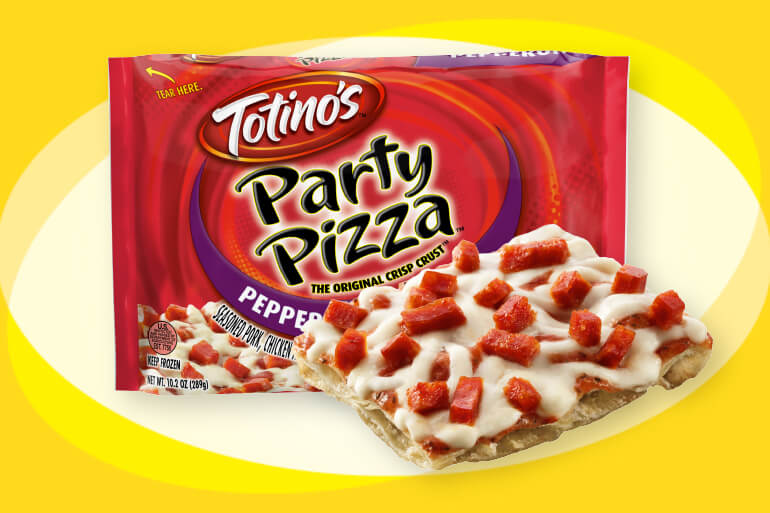The Queen of Frozen Pizza
... or at least the crispy rectangle.

Mmm, quadrilaterals. (credit below)
Pizza is so quintessentially American, so tightly bound to our most cherished institutions (Home Alone, the Ninja Turtles, Papa John Schnatter’s greasy racism) that it’s tough to imagine it being considered a fringe “ethnic” food. But that was very much the case in most of the country until the ’60s, and it’s a Minnesota nonna named Rose Totino we can thank for popularizing it outside the realm of the niche.
She was born Rosenella Cruciani in 1915, to first-generation Italian immigrant parents. She married young, to Jim Totino, and raised kids before starting her career. Jim was the trained baker, but Rose was the tour de force, the face of the business, and the one we remember for bringing pizza to the masses.
The generally accepted story is that pizza—and Italian food in general—gained popularity in the U.S. after American G.I.s returned from World War 2 tours in Italy with a newfound hunger for the stuff.1 But Minnesota in the 1950s wasn’t cosmopolitan multicultural New York, and the small Italian-American enclave of northeastern Minneapolis had limited cultural and gustatory reach among the Norwegians and Germans and Poles of the frozen north. This proved a challenge for a young Rose Totino and her husband Jim. An oft-told part of the Totino’s legend goes that, when applying for a loan to open their first pizza restaurant in 1951, the banker had no idea what pizza even was. Rose went home, slapped one in the oven, brought it back and served it to the loan officer, and—ecco qua!—walked out with $1,500.
That loan went into Totino’s Italian Kitchen, a Twin Cities institution that operated in its Central Avenue location until 2007. Locals adored their “Italian pies” so much that they added seating and expanded, serving as many as 500 pizzas a day. But the Totinos could only feed so many people from one store. In order to feed the nation, they needed to turn to the Holy Grail of Cold War cuisine: the freezer.
Let’s be real: These days, that square elfin Totino’s pizza from the grocery freezer can barely be considered pizza at all. It’s a dry dusting of cheese, some microscopic pepperoni crumbs, a miserly smear of sauce: what comes out of the oven (or, shudder, the microwave) when you’re too hungry or too drunk to care much about what you’re eating. But the crust below all those crappy toppings was Rose’s innovation, her legacy, and why Totino’s sells 300 million of the damn things a year.
Frozen pizza existed before Totino’s, but it was barely edible.2 Dough is a complicated and delicate structure, and the ballet between gluten and ethanol and yeast was promptly flattened by the Mack truck of freezing it; ice crystals got in and destroyed the structure of the dough, rendering a cooked crust tasteless and crumbly. This didn’t stop the public from buying the crap out of the frozen version Totino’s produced from their Fridley, MN plant beginning in 1962—as we well know, shitty pizza is almost always better than no pizza, and Totino’s was the first frozen pizza with nationwide distribution—but the lack of quality always bothered Rose.
Her solution? Totino’s “Crisp Crust,” a delamination-resistant fried-dough crust you’ll find under U.S. Patent Number 4170659A. It is, to wit, “… a flat at least partially fried body of soft porous dough and crispable outer crust with a plurality of blisters having generally hemispherical upwardly extending domed upper surfaces.” What that means is that the crust is carefully layered and par-fried before adding toppings and freezing, which is why every Totino’s you’ve properly cooked ends up crispy. At the time, this was a major innovation that immediately set the brand apart from the competitors’ cardboard-ass crusts.

Assisting her in the delamination-resisting was the dedicated crew of Pillsbury food scientists who became Rose’s underlings after Pillsbury acquired Totino’s in 1975. For her brand, she got $22 million, a rumored $9 million in stock, and was made Vice President of Frozen Foods. She was the company’s first female executive. 3
Rose died in 1994, her legacy secured. For her work, she was inducted into the Minnesota Inventors Hall of Fame posthumously in 2008, where she’s in august company. Other inductees include:
- Patsy O. Sherman, the 3M chemist who co-invented the water- and stain-repellent class of chemicals that comprise Scotchgard. Those same chemicals, as it turned out, were, like, real bad—perfluorooctane sulfonate, in particular, is a carcinogen that now pollutes drinking water worldwide. 3M eventually paid a $850 million settlement to the state of Minnesota over it. But look on the bright side: it helped some couches resist spaghetti stains. Thanks, Patsy!
- James J. “Crash” Ryan, the inventor of the retractable seatbelt, the collapsible car bumper, and the aircraft black box. He was absolutely fanatical about vehicle safety, and was known for strapping himself into crash harnesses and helmets … and that’s how he died (just kidding, it was heart disease!).
- Dr. Owen Harding Wangensteen. We don’t know what he did, because we refuse to look it up—anything factual would ruin that glorious, glorious name for us. (Our current favorite headcanon: he built a most splendiferous flying machine.)
Rose’s presence lives on outside the freezer aisle in Minnesota culture. While the family restaurant shuttered for good in 2011 (a hapless grandson moved it to the ‘burbs, where it limped along for five years before closing), the University of Northwestern, St. Paul, has a Totino Fine Arts Center, about which we ask you to kindly hold back your jokes. And Fridley is home to Totino-Grace, a Catholic school known for their performing-arts and choral programs. Totino-Grace’s school lunch menu at time of this writing includes French bread pizza.
1 This is the same origin story for the popularity of oral sex. Turns out, soldiers exposed to the pleasures of hot-blooded Mediterraneans duly imported an appetite for those pleasures back to the puritanical U.S.A. Despite that, oral sex was still a felony in 48 states in 1950. It took Kinsey, Deep Throat, and The Godfather to normalize it by the ‘70s. C’mon, America!
2 Celentano Brothers were probably the first to market a frozen pizza, in 1957. They were on the market as late as 1980, with an ad campaign starring conservative radio guy Barry Farber. Farber is perhaps best known for losing a New York City mayoral race. Celentano Bros. are probably best known for not making pizza anymore.
3 Around this period is when Pillsbury acquired the other Totino’s product you know, the pizza roll, originally sold under the brand name Jeno’s. Jeno’s was started by the same guy who gave us the Chun King line of frozen Chinese foods. And now that you know that, you can never un-taste them as cheese-filled egg rolls.
A version of this story appeared on the news page of Questionist’s parent company, Geeks Who Drink.
Featured image: totinos.com
